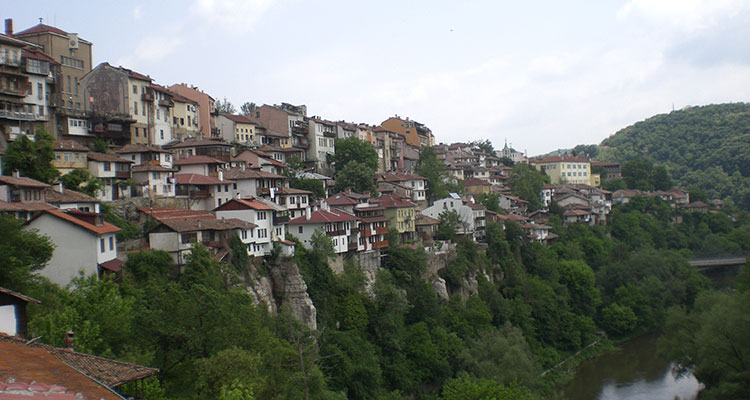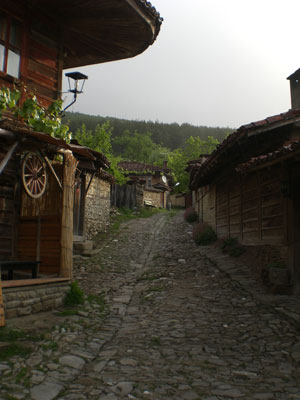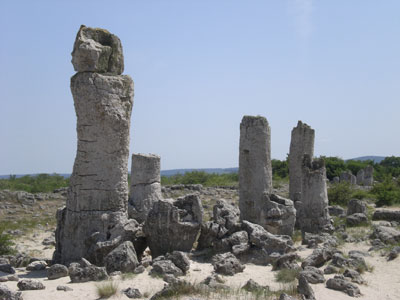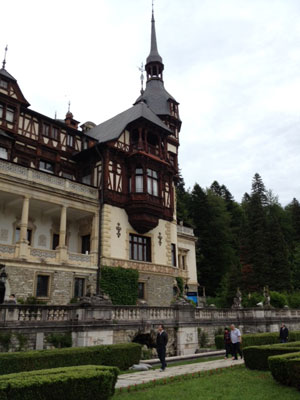Bulgaria and Romania — Enjoying Eastern Europe by private car
This article appears on page 32 of the January 2013 issue.
by Nita & Charles Swartz; Las Cruces, NM
Interested in visiting Bulgaria and Romania for some time, we at first considered renting a car for a self-drive tour, but after reading several reports on road conditions, the difficulty of driving in these two countries and the fact that road signs in Bulgaria would, for the most part, be in the Cyrillic alphabet, we quickly abandoned this idea.
We next checked into the possibility of taking a group tour but found them to be expensive, plus they didn’t include all of the sites in which we were interested.
Then we read an article in ITN by Ken Goe (Sept. ’11, pg. 33) in which he wrote that he had been very pleased with a tour of Bulgaria led by a private guide, Patrick Peneff. We had never taken such a tour and were somewhat apprehensive, but we contacted Patrick by e-mail to inquire about his arranging and leading a tour of Bulgaria for us.
He asked about our interests and offered a possible itinerary. We made several suggestions, mostly regarding not having so many one-night stays, and eventually were satisfied, signing on for a trip which began May 7, 2012.
The cost of our 16-day tour was $3,452 for two, including transportation in Patrick’s Honda SUV; airport transfers; lodging, and daily breakfast. Other meals and entrance fees were extra expenses. (The entrance fees totaled about $200.) Food was very inexpensive. One could have a very nice meal with beer or wine for $10-$15, except in upscale restaurants.
As we also were interested in visiting Romania, we asked Patrick if he knew of any driver/guides for that country. He gave us several suggestions, and we eventually contacted Andrei Nicolau Miclea of Compass Travel Romania (phone, in the US, 855/827-0827).
We chose the 12-day “Romanian Rhapsody” tour at a cost of $3,906, including airport transfers; transportation in a Ford SUV (owned by our driver/guide George Codrin Buliga); lodging, including daily breakfast; all entrance fees, and several dinners. As in Bulgaria, meals were quite inexpensive, although they were slightly more expensive than those in Bulgaria.
Food in both countries was good. We enjoyed a variety of local dishes each day.
It should be noted that Andrei seems to be a contractor who hires freelancers to guide his tours. George ([email protected]) leads many of Andrei’s tours and can organize independent tours as well.
Great guides
Both of our guides were excellent. They were very informative about the histories of their respective countries and knew their way around the small back roads, taking us to sites that tour buses could not access. Very adept at dodging the many potholes along the way — a useful skill, particularly in Bulgaria — they both were very competent, safe drivers in countries where not all drivers seemed sane.
Among the advantages of a private tour are the flexibility of making unscheduled stops and, more importantly, the interesting tidbits you can learn about the country from your guide. Patrick and George were always willing to discuss any subject.
We requested accommodations in small boutique hotels, and the hotels/pensions in which we stayed were beyond our expectations.
Sofia sights
We arrived in Sofia after the long journey from our home in Las Cruces, New Mexico. We were met by Victor Kostov (phone +359 896 865 800), with whom Patrick contracts to do airport transfers and give a city tour on arrival day.
Victor has several short-term rental apartments in central Sofia, and we stayed in one of his apartments for three nights after our arrival and for one day before departing for Bucharest. The apartments were very conveniently located and were quite comfortable, although the buildings did not have elevators.
Before our city tour, we stopped at an ATM to obtain leva, the Bulgarian currency. It should be noted that one must use the local currency in both countries; euros and dollars are not accepted.
Our city tour of Sofia included the UNESCO-protected Boyana Church, a medieval Bulgarian Orthodox church built between the 11th and 19th centuries. The church is know for its nearly 90 colorful frescoes. Dating from as far back as 1259, they are considered among the finest examples of medieval Bulgarian art.
The awesome, gold-domed Aleksandar Nevski cathedral is the pride of Sofia. It was constructed between 1882 and 1912 as a memorial to the 200,000 Soviet soldiers who died fighting for Bulgarian independence. The National Ethnographic Museum was also interesting, with displays of folk costumes, carpets and carvings.
Victor did an excellent job of showing us his city and describing its history. Sofia is an energetic, modern city. It is pleasingly compact, and most, if not all, of the main sights are easily reached on foot. There was a lingering Soviet tinge, evident in the blocky architecture, but there were also fine parks, wonderful museums and beautiful churches.
The tour begins
On our third day, Patrick arrived in Sofia from his home in Varna and we started our guided tour. We began with a day tour to the Rila Monastery, about a 1½- to 2-hour drive into the snowcapped mountains that snuggle up to the Greek border south of Sofia.
First built in 927, heavily restored in 1469 and rebuilt after a fire engulfed most of its buildings in 1833, the monastery helped to keep Bulgarian culture and language alive during Ottoman rule. Its Nativity Church contains 1,200 magnificent murals.
The following day we traveled to Veliko Tarnovo, the medieval capital of Bulgaria, with stops along the way at the ruins of the Roman fortress of Sostra and the Troyan Monastery. In Veliko Tarnovo we took a city tour, visiting the impressive Tsarevets fortress. This triangular, high-walled fortress includes the remains of more than 400 houses and 18 churches. Built in the 12th century, it was nicely reconstructed during the Communist era.
Lunch was in the beautiful small town of Tryavna, which should be called the woodcarving capital of Bulgaria. The town was a delight, with cobbled streets and beautifully restored National Revival architecture. Some of the houses were open to the public, showing off their intricate interior carvings.
This was followed by a day trip to the village of Arbanasi, where we found beautiful floor-to-ceiling frescoes in the 16th-century Nativity Church and elaborate woodcarvings and icons in the Church of Saints Archangels Michael and Gabriel.
In Veliko Tarnovo we stayed at the very charming Hotel Gurko, located on a hill overlooking the city.
Varna
We next journeyed to Varna, Patrick’s home city. On the way, we stopped to see Pobiti Kamani, the Stone Forest, consisting of thousands of tree-shaped limestone structures, some 30 meters tall. Some geologists believe that the columns (which are mostly hollow) date back 50 million years, when much of Eastern Europe was still at the bottom of the ocean. Millions of years later the area became dry and the surrounding sand slowly eroded to leave these spectacular stone chimneys.
The following day we were off to places near Varna, including Balchik, a small, pretty town and fishing port that is home to the Gardens of Balchik and the Palace of Queen Marie.
In the 1920s, when the region belonged to Romania, the Romanian King Ferdinand built this summer palace and its botanical gardens for his wife as a place of solitude.
The modestly sized palace consists of several structures for their children and for guests and shows off Marie’s eccentric tastes, mixing Islamic and Bulgarian decorative styles. The gardens feature a water mill, chapel and winery and more than 2,000 plant species.
Back in Varna we had dinner at a very nice seafood restaurant, Mr. Baba, with Patrick and his lovely wife.
On our last day in Varna we took a very long drive to see the Thracian Tomb of Sveshtari. The drive was definitely worthwhile. This UNESCO World Heritage Site has a unique architectural design, with half-human, half-plant caryatids (columns in the shape of women) plus painted murals. This was the most spectacular tomb that we visited on this trip. Truly amazing!
Jeravna and Kazanlak
We next drove (in heavy rain) to the small village of Jeravna (Zheravna) for a stay in a 300-year-old house. After we got settled in our room, Kunka, the property manager, invited the three of us for a delicious dinner. Everything was fresh and homemade, including the plum brandy and red wine. She grows her own vegetables, has chickens and pigs and is an excellent weaver. This lady can do anything! It was a delight to meet Kunka and her grandson on this very special homestay.
Heavy rain resulting in flooding caused us to miss our next scheduled stop. Instead, we went to Kazanlak, the home of the Rose Festival and countless Thracian tombs. We stayed in the delightful Hotel Roza, overlooking the city square.
This is the valley where the roses used to make rose-oil are grown, and a visit to a rose oil distillery proved to be very interesting. We also enjoyed the Museum of Roses, which had a small exhibition on the history of rose cultivation.
Outside the town lie more than 500 Thracian burial mounds, though only a few have been excavated. With Patrick’s tremendous knowledge of the area, we would drive across open fields, pick up someone with a key and visit a tomb in the middle of nowhere. This is the advantage of having a driver and experienced guide!
Plovdiv
We moved on to Plovdiv, where we spent three nights at the charming boutique Hotel Renaissance, which had quite a nice restaurant and café. The hotel is near the Old City center, which contains a number of interesting sights all within walking distance.
Here our exciting trip of beautiful Bulgaria came to an end. Leaving the charming Hotel Renaissance and Plovdiv, we made the drive back to Sofia and said good-bye to our new friend Patrick. After a one-night stay in one of Victor’s apartments, we flew on to Bucharest. (I might add that Victor was there on time to take us to the airport, and he made sure that all was okay before leaving us.)
Bucharest
At the airport in Bucharest, we were met and taken to the Howard Johnson Hotel. We were scheduled to stay at Hotel Berthelot, but they were hosting a conference and had no vacancies. (We did stay at Hotel Berthelot on our return to Bucharest at the end of the trip.) After checking into the hotel and exchanging dollars for leu, we walked through the Old Town.
Some of the most heart-wrenching anti-protester violence of the April-June 1990 student protest took place at Piaţa Universităţii in the historic quarter. You will find bullet marks in some of the buildings and 10 stone crosses commemorating those who were killed.
In the evening, our driver/guide, George, met us at the hotel and took us to a dinner-and-folklore show in one of the beautiful city parks.
The next morning we were to take a city tour and visit the open-air village museum and a 1930 downtown residence, but, due to pouring rain, we instead had an auto tour of some of the major sights of the city.
We also visited Ceaușescu's Palace of the Parliament, a most remarkable structure though it was built on the backs of the poor Romanian people. The floor area of at least 330,000 square meters ranks this building as the second-largest administrative building in the world, after the Pentagon.
Almost everything, from the construction material to the beautiful ornate furnishings, paintings, carpets and opulent marble, came from within Romania.
To Transylvania
After the tour of the parliament, we set out for Sibiu, capital of the Transylvanian Saxon towns founded in the 12th century, stopping at the 14th-century Cozia Monastery on the way. This monastery is known as the most important artistic monument in Romania. It has magnificent stained-glass windows that survived by being hidden in the attic of the monastery. The Romanian monasteries are remarkable for their frescoes, both inside and out.
In Sibiu we stayed in the center of the old medieval city at the very elegant Hotel Imparatul Romanilor. The following morning, we took a walking tour of the Old Town and the beautiful square and went through the Brukenthal Museum, probably the finest art gallery in Romania. It was founded in 1817 in the Baroque palace of the former Austrian governor.
The 3-room Pharmacy Museum, located in a 15th-century pharmacy, was packed with pills, powders and scary medical instruments that you wouldn’t want to be used on you today!
We then continued our journey to Cluj-Napoca, with a stop at the 14th-century Gothic Hunyad Castle. This is one of the most well-preserved Gothic castles of Transylvania and is the home of the mighty Hunyadi royal family.
In Cluj-Napoca we stayed at the Siago Hotel, within walking distance of the city center.
The next morning we visited the Ethnographic Museum of Transylvania, which offered two floors of well-presented displays featuring tools, weapons, handicrafts, toys and household items, with detailed descriptions in English.
Maramureș
Continuing our drive through the mountains, we reached the village of Iza in Maramureș for a 2-night stay in a very comfortable private home. This stay was quite interesting and offered an opportunity to interact with locals. On a walk through the village, we observed several homes with beautifully tiled exteriors and well-tended gardens. We stopped at a tavern for a drink, wanting to communicate with some of the people. Nita joined several of the local ladies for a neighborhood gossip session (though she couldn’t understand any of it).
The man of the house in which we stayed arranged for a folklore group with which he plays to entertain us after we enjoyed a wonderful dinner prepared by his wife. The next morning we attended Sunday services at the local Orthodox church.
We also visited a compound in which a waterwheel supplied power for everything from a plum brandy distillery to a whirlpool used by the local women to wash heavy woolen blankets and carpets. This amazing operation was built by one individual for the community to use free of charge. If possible, those using the facility bring food from their garden or other nonmonetary gifts as payment.
Remembering the lost
A day trip to the neighboring village of Sighet to once again mingle with the locals — this time at the colorful fruit and vegetable market, where we sampled a variety of produce — made for an enjoyable day.
Next we visited the Memorial to the Victims of Communism and to the Resistance, a political prison during Communist times. This is one of the main memorial sites on the Continent, in addition to Poland’s Auschwitz Museum and the Peace Memorial in Normandy.
While many leading prewar figures were sent to hard-labor camps, the regime’s most feared intellectual opponents were interned in Sighet’s maximum-security prison. Between 1948 and 1952, about 180 members of Romania’s academic and government elite were imprisoned there. Four white marble plaques covering the barred windows of the prison list the prisoners who died in the Sighet cells.
We continued along the Tisza River to reach the unassuming village of Săpânţa, world famous for its “Merry Cemetery,” which has colorfully painted, epitaph-inscribed wooden crosses adorning the graves. Shown in art exhibitions across Europe, the crosses attract visitors, who marvel at the gentle humor and human warmth of the inscriptions.
We continued exploring Maramureș along the picturesque Iza Valley, stopping in the village of Rozavlea, known for its spectacular carved gates. We visited a master carver who represented Romania at the 1999 Smithsonian Folklife Festival in Washington, DC. He welcomed us to his workshop and we watched him work on an enormous gate.
Bucovina
We then headed for the neighboring region of Bucovina, a rural paradise on a par with Maramureș. It was designated a UNESCO World Heritage Site in 1993 for its distinctively painted monasteries, which date to the 15th to 16th centuries.
Next we crossed the Carpathian Mountains through the picturesue Prislop Pass into Bucovina, to the north of the region of Moldavia.
In the town of Câmpulung, we enjoyed an egg-painting demonstration by a local artist in her home, this being one of the local traditions of the area. She was also kind enough to show us her extensive private collection of painted eggs.
After arriving in the town of Gura Humorului, we checked into Casa Humor for a leisurely evening. The hotel was centrally located and an easy walk from the city center.
The painted monasteries of Bucovina, another UNESCO World Heritage Site, are gems of medieval Moldavian architecture and artistry. Voroneț, the most famous of them all, is known as the Sistine Chapel of the East and features one of the best “Last Judgment” frescoes in Eastern Europe. It could easily be one of the most marvelous frescoes in the world!
After a relaxing lunch, we continued to the nearby Sucevița Monastery, the largest, looking more like a mighty fortress than a monastery. The church inside the fortified quadrangular enclosure, built between 1582 and 1601, is almost completely covered in frescoes. As you enter, you first see the “Ladder of Virtues” fresco, depicting the 30 steps of Paradise, covering most of the northern wall. On the southern wall is a genealogical tree illustrating the continuity of the Old and New Testaments. To the left is the Virgin, with angels holding a red veil over her head.
Mysteriously, the western wall remains blank. Legend has it that the artist fell off his scaffolding and died, leaving artists of the time too scared to follow in his footsteps.
We ended our day with Humor Monastery, the only one without a belfry. Of all of Bucovina’s monasteries, Humor Monastery has the most impressive interior frescoes. On the south wall of the 1530 church you’ll see the life of the Virgin Mary depicted; on the left is St. Nicholas, and the parable of the prodigal son is on the right. On the porch the Last Judgment is shown, and in the first chamber inside the church are scenes of martyrdom.
Sighişoara
We began the next day with a drive south to Piatra Neamţ for a tour of the only wooden synagogue in Romania (dating back to the 18th century). On our way to Sighişoara, we passed through the spectacular Bicaz Gorges, where the surroundings were dramatic.
We arrived early in the afternoon for a one-night stay in Sighişoara, another UNESCO World Heritage Site and one of the best-preserved still-inhabited medieval citadels in Europe. Our hotel, Casa cu Cerb, was in the upper-level medieval citadel, a perfect location. Prince Charles had stayed there for a few days in 2002.
Sighişoara is one of a kind and was a favorite of ours. Developed by German settlers in the late 12th century, it stands on a network of tunnels and catacombs. According to one version of the story, it is where the Pied Piper brought the children of Hamelin after their ungrateful parents refused to pay him his due.
Our walking tour included the two squares of the upper citadel, with visits to the clock tower, the torture chamber and the medieval Weapons Museum.
Sighişoara is also famous as the birthplace of Vlad the Impaler, aka Dracula, his birthplace now a restaurant/tavern.
We would have enjoyed another night in this delightful town.
Valeni
George arranged for us to visit the home of a local Roma family — a very enlightening stop. We didn’t know what to expect, but the family was gracious and kind and had refreshments prepared for us.
Romania’s more than 600,000 “Gypsies,” properly called Roma or Romani, suffer widespread discrimination. The majority lives in the towns and villages. Some are fully integrated into the villages, some live in large, ornate houses outside of the Romanian communities, and others live in small buildings on scraps of land on the villages’ edges.
Our host, Klara Gabor, has established a bed-and-breakfast and offers day tours available through her company, Tzigania Tours. I’d recommend adding this stop to your Romania trip.
Touring Transyvania
We left Sighişoara for a journey south through the picturesque Transyvanian Plateau. Our tour of Brașov included Rope Street, the narrowest street in Romania. At 111 to 135 centimeters (44-53 inches) in width, it was designed to be an access corridor for firemen. Today it is only a walking path.
Brașov’s most important landmark is the Black Church, with its 4,000-pipe organ and the more than 100 Anatolian prayer rugs that were given to the church as gifts by rich Brașov merchants. The large Gothic church, built between 1385 and 1476, towers over the Old Town.
Originally dedicated to the Virgin Mary, the church was Roman Catholic for more than 1½ centuries. With the Reformation, it became Lutheran. A great fire in 1689 blackened the walls, and the church was renamed Black Church. It took approximately 100 years to restore.
On the way to Sinaia, the attraction of the afternoon was Bran Castle, also known as Dracula’s Castle, though Vlad dropped by only once in the 15th century (maybe). There are numerous “Dracula” castles and hotels throughout Romania; Vlad’s actual castle is a ruin atop a hill.
The atmospheric Bran Castle dates from the 14th century and was built to safeguard trading routes. It was restored as a royal residence by Queen Marie in the 1920s.
Continuing on to Sinaia, we visited the most spectacular site of our Romanian tour, Peleș Castle. Built at the end of the 19th century, this castle is not as large as some of the more well-known European castles, but we found Peleș to be more elegant, featuring endless elaborate rooms with heavy, wood-carved ceilings and gilded furnishings.
Little did King Carol I know that his decadent summer residence, designed to invoke envy in visiting royalty, would eventually be overrun by gawking tourists. It has fairy-tale turrets and grand reception halls — all still grand centuries later. Worthwhile and compulsory tours point out amazing features, including the groundbreaking central vacuuming system. If you saw nothing else, Peleș Castle would be worth a visit to Romania.
Comparing countries
If you were going to visit only one of the two countries we toured on our trip, which one should be chosen? Bulgaria has more ancient sites. There is an abundance of Roman ruins scattered throughout the country and innumerable Thracian tombs and temples, though Bucharest does have Roman ruins.
The mountainous scenery in northeast Romania is strikingly beautiful, the many horse-drawn farm wagons adding to the charm.
Both countries have an abundance of monasteries.
Another thing both countries share is a history of Communism, though different “brands.” Bulgaria was very closely aligned with the Soviet Union, so life was not as difficult as it was in Romania, which suffered through harsh Communist dictators, the worst, of course, being Ceaușescu. Both of our guides were teenagers when Communism fell, and it was very interesting to hear their stories.
When we discussed which country we liked best, one of us (Nita) picked Bulgaria, as she liked the food and the many monasteries and churches, while the other (Charles) picked Romania, mostly because of the spectacular Peleș Castle. In truth, one cannot go wrong in visiting either country, as each is extremely interesting and has a wealth of history.
If you have questions or comments, feel free to contact us via e-mail c/o ITN.






